2008 Display of the Year Award Winners Show the Future is Now
From the commercialization of OLED displays to the rebirth of 3-D cinema, the best display products of 2007 point to the realization of many years of research and development.
by Michael Morgenthal
AS THE FIRST DECADE of the 21st century starts to wind down, the display products that are entering the marketplace are taking on a decidedly futuristic bent. This is illustrated perfectly by the six winners of the 2008 SID/Information Display Display of the Year Awards. From the commercialization of organic-light-emitting-diode (OLED) technology to innovative uses of touch technology, 3-D stereoscopic technology, and LED backlighting breakthroughs, the 2007 winners show the strength of the imagination of those currently designing displays, display components, and display applications right now.
"The Display of the Year Awards is hands down the most prestigious accolade commend-ing the chief influential technologies across the global display community," said Dick McCartney, SID's Display of the Year Com-mittee Chair. "The high caliber of products and technologies nominated this year has certainly made the decision process tough on our Awards Committee, but among the significant numberof nominations received from around the world, these six products transcended."
A distinguished panel of display experts selected these six products as winners of the most prestigious awards in the display industry from the myriad entries submitted based on their technical innovation and commercial significance, in addition to their likely social impact. In order to qualify for a 2008 Display of the Year Award, a product had to be introduced into the marketplace (e.g., available for purchase) during the 2007 calendar year.
"On behalf of SID, we would like to truly commend the award winners' ongoing commit-ment to innovation and to shaping the future of today's display arena," McCartney added.
The 2008 Display of the Year Awards will be officially presented during the annual Display Week Luncheon on Wednesday, May 21 at 12 noon in the Concourse Hall 151 of the Los Angeles Convention Center. Tickets for the luncheon cost $35. During the ceremony, the three 2008 Gold Award winners will each present a short video describing the winning product.
The award-winning displays, components, and applications are described here, based on information supplied by the winning companies.
Display of the Year
This award is granted for a display with novel and outstanding features, such as new physical or chemical effects, or a new addressing method.
Gold Award: Sony Corp. – OLED TV XEL-1, The World's First OLED TV
The promise of OLED TV has been on the horizon for several years, and Sony won the race to market with its XEL-1, the world's first1 commercially produced OLED TV. Stunningly thin with an incredible picture quality, the XEL-1 earned the Gold Award in the Display of the Year category. Sony has changed the form factor of television by delivering flawless picture quality that could soon become the standard against which all TVs are measured. The 11-in. (measured diagonally) XEL-1 model is about 3 mm thin at its thinnest point and offers picture quality with extremely high contrast, outstanding brightness, exceptional color reproduction, and a rapid response time. It was introduced Dec. 1, 2007 in Japan and in January 2008 in the U.S. and incorporates Sony's independently developed "Organic Panel."2
The "Organic Panel" has been under development for more than 10 years. With its light-emitting structure, OLED displays can prevent light emission when reproducing shades of black, resulting in very deep blacks and a contrast ratio of more than 1,000,000:1. The lack of a backlight allows the device to control all phases of light emission from zero to peak brightness. The innovative technology delivers exceptional color expression and detail without wasting power, so it is an exceptional energy-saver. Since OLED technology can spontaneously turn the light emitted from the organic materials layer on and off when an electric current is applied, it features rapid response times for smooth, natural reproduction of fast-moving content such as sports and action scenes in movies.
1As of October 1, 2007. Based on Sony research.
2Name of Sony's OLED panel and module.
The "Organic Panel" features Sony's unique "Super Top Emission"3 technology, with a wide aperture ratio producing high brightness and efficiency allowing the TV to deliver an accurate picture. The device's proprietary color filter and micro-cavity structure allow it to reproduce natural colors – even in darker scenes – and more faithfully recreate the colors that were originally intended.
3Sony's OLED device structure adopts both top-emission and micro-cavity structures of the organic layer simultaneously.
"Super Top Emission" adopts the Top Emission and micro-cavity structure of the OLED layer, which enables higher brightness and leads to less power consumption and more accurate color reproduction. Top Emission refers to extracting light from the sealing substrate. To extract light from the cathode side in the Top Emission structure, the cathode must be transparent, or half-transparent with a metal cathode. The method of extracting light from the TFT substrate side is called Bottom Emission. Because drive circuits are placed on the TFT substrate in this method, the area from which light can be extracted is limited. The micro-cavity effect is achieved by optimizing the organic film thickness between reflective anode and half-reflective cathode, i.e., the optimum optical path length. Thus, the thickness of the organic layer of each color is different. The micro-cavity effect enables the designated peak of the spectrum of emitted light, enhancing and sharpening the light and allowing the micro-cavity structure to achieve high brightness and high color purity simultaneously.
"Super Top Emission" adopts other unique technologies, including the color filter and complete solid-state encapsulation. Combining the color filter with the micro-cavity structure, by which ambient light reflection can be almost reduced, allows higher contrast, higher efficiency, and lower power consumption without employing a circular polarizer on the panel surface. Its all-solid structure, achieved by a transparent inorganic buffer layer on the substrate and bonding the sealing substrate together by resin with no air gaps, allows XEL-1's surprising thinness. A typical OLED panel with an inert-gas-enclosed air-gap structure is more susceptible to damage by external mechanical shock, and the damage can be more significant when the screen size is larger. This complete solid-state technology will allow the manufacture of OLED panels that are even larger in size and thinner in thickness, with the possibility of achieving a super-thin paper-like display with a plastic film substrate.
Silver Award: Samsung SDI Co. Ltd. – 2-in. QVGA Ultra-Slim Low-Power High-Contrast Wide-Color-Gamut AMOLED Module
Not all of the attention for OLEDs in 2007 went toward the efforts to develop OLED TV, however. Samsung SDI's 2-in. QVGA ultra-slim low-power high-contrast wide-color-gamut AMOLED module, which started mass production in August 2007, represents the vanguard in OLEDs for mobile displays, which is why it earned the Silver Award in the Display of the Year category.
This product is a 2-in. QVGA AMOLED module that is used in the Nokia Prism and Arte collections of mobile phones. It contains applied fine-metal-mask (FFM) evaporation technology on low-temperature poly-silicon (LTPS) substrates. This AMOLED display has a resolution of 240 x 320, a luminance of 180 cd, a viewing angle of 180° (all directions), no visible flickering, 100% color gamut in comparison to NTSC with up to 16 million colors, and a power consumption typically around 120 mA. This model is the strongest entrant yet to compete with TFT-LCDs in the high-end mobile-phone market, thanks to its slim form factor, low power consumption, extra-wide color reproducibility, and extremely high contrast ratio.
Samsung SDI was the first company to mass produce AMOLEDs and is now manufacturing 1.5 million AMOLEDs a month, a number that is expected to double by next year.
|
DISPLAY OF THE YEAR
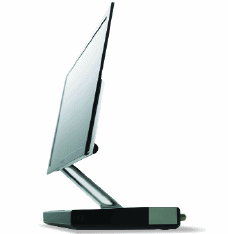
Gold Award: The Sony XEL-1 is the first commercialized OLED TV.
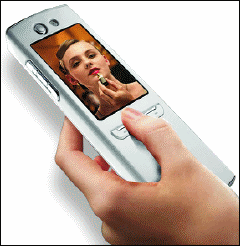
Silver Award: Samsung's 2-in. QVGA AMOLED is currently being used in Nokia cell phones.
|
Display Component of the Year
This award is granted for a novel component that significantly enhanced the performance of a display. A component is sold as a separate part destined to be incorporated into a display. A component may also include display-enhancing materials and/or parts fabricated with new processes.
Gold Award: Luminus Devices, Inc. – PhlatLight Backlight Unit
Replacing cold-cathode fluorescent (CCFL) backlights with LEDs has spurred considerable interest among manufacturers striving to differentiate their large-screen products. LEDs are more efficient, have longer life and high reliability, are mechanically robust, and are more environmentally friendly than CCFLs. However, such advantages have traditionally come with a cost because most LED-based backlight units being developed use conventional white LEDs requiring hundreds or thousands of LEDs to achieve adequate brightness and uniformity. This high-cost approach requires an impractical number of components and involves controlling a large number of LEDs to maintain brightness uniformity over the entire screen.
Edge-lit backlight units are favored in small LCDs for cell phones, portable DVD players, and notebook computers because they enable very thin form factors with low part counts to reduce system cost and complexity while improving reliability. Conventional LEDs, however, are unable to couple sufficient light into light guides for large edge-lit LCD TVs.
As manufacturers of the world's brightest LEDs, Luminus Devices has already made a considerable impact on the display market, having successfully proven its PhlatLight® LEDs as suitable replacements for mercury-arc lamps used in projection TVs and projectors. This experience provided Luminus with the insight and understanding to apply the unique characteristics of its PhlatLight technology to other display applications. The high flux and collimated light output of PhlatLight LEDs have now enabled, for the first time, edge-lit backlight units (BLUs) for very large-screen LCD TVs with diagonals larger than 40 in. This innovation has earned Luminus Devices the Gold Award in the Display Component of the Year category.
PhlatLight LEDs are the only LEDs bright enough to edge light large BLUs. Luminus incorporated its proprietary state-of-the-art technologies, including photonic lattice and advanced packaging, to develop a new PhlatLight RGB module that is specifically optimized for LCD-TV edge lighting. Based on extensive system-engineering work, the PhlatLight BLU is a modular LED edge-lighting system that uses these high-flux PhlatLight LED modules to couple light into a MicroLens™ light guide that is provided by Global Lighting Technologies.
This novel backlight is scalable to larger screen sizes in an ultra-thin form factor and uses significantly fewer LEDs to bring the benefits of RGB LED backlighting to manufacturers. These benefits include a wider color gamut, long lifetime, and the absence of mercury. Intelligent features, such as progressive scanning, are more easily implemented with the design's dramatically reduced LED count, while color uniformity and brightness are maintained for the life of the TV. A 46-in. PhlatLight BLU requires only eight PhlatLight LED modules and provides a cost-effective mass-market solution not possible with any other type of LED-based backlight unit.
The low LED count in the PhlatLight BLU solves another key problem of LED backlight units: cost. By eliminating some of the packaging costs associated with conventional LEDs used in direct-lit systems, and substituting thousands of small packages with a few high-performance packages, the PhlatLight BLU can reduce the combined LED chip and packaging cost by as much as 40%. This is a very significant advantage, considering that cost has proven the main hurdle to widespread adoption of LED backlighting for large-screen LCD TVs.
The PhlatLight BLU is making the large-screen LED-backlit LCD TVs viable by reducing the price premium of LED backlights and driving the adoption of LED backlighting into mass markets. High-volume production and system scalability to larger and smaller sizes will help bring the performance and ecological benefits of LED backlighting to all types and sizes of TVs, monitors, and digital-signage displays, with LCD TVs incorporating PhlatLight LED backlight units expected in stores by the end of 2008.
Silver Award: FUJIFILM Corp. – WV-EA Film
LCD monitors have almost totally replaced CRT monitors in the PC monitor market. Twisted-nematic (TN) mode LCDs are widely used in these monitors because the TN mode provides high light transmittance, relatively fast response time, ease of manufacture, and cost effectiveness. However, the viewing-angle performance in TN mode is poor compared to that of other modes. To solve this problem, many approaches were proposed, and the most successful method was the use of Wide View (WV) film. FUJIFILM has developed several WV films (first generation, "WV-A"; second generation, "WV-SA"; third generation, "WV-EA") and expanded the oblique viewing angle for TN-mode LCDs.
The WV film is an optical compensation film that enhances the large field of view of TN-mode LCDs. By using WV film, the viewing-angle performance is improved and clear images can be seen at oblique angles.
Before now, TN-mode LCDs were mainly used for monitors smaller than 19 in. In monitors larger than 19 in. and TV sets bigger than 20 in., IPS or VA mode were the norm, but of late, TN-mode LCDs have been appearing in these larger-sized displays as well due to lower cost, the faster response time of TN-mode LCDs, and the improvement of WV film. In particular, the development of "WV-EA" contributes to the size expansion of TN-mode LCDs. "WV-EA" is a new WV film for TN-mode LCDs suitable for large-sized wide-aspect-ratio LCD monitors and LCD-TV sets.
The "WV-EA" film that was initially developed in 2005 achieved a further viewing angle expansion (see figure) for monitors, but not for TV applications because of the existence of mura on the coating surface.
The thickness mura (non-uniformity or unevenness) in the alignment and polymerized discotic material (PDM) layer occurred with the conventional coating method, mainly caused by the fluctuation of airflow in the drying process. This mura gave rise to optical fluctuation, and it was a critical issue for larger panel sizes. Some additives were used and adjusted to improve the thickness mura. However, it is quite difficult to control both the thickness uniformity and the viewing-angle performance because the additive changed the optical properties of the WV film.
The "WV-EA" film introduced in 2007 has succeeded in remarkably improving the thickness uniformity. Here, FUJIFILM has introduced new airflow control technology with the precise control of airflow directions and speed in the drying chamber. In addition, we have developed a new additive that makes compatible the thickness uniformity with the optical properties. These improvements have allowed the "WV-EA" film to expand in TV applications, which have never been possible with the conventional WV films. For this achievement, FUJIFILM has earned the Silver Award in the Display Component of the Year category.
|
DISPLAY COMPONENT OF THE YEAR
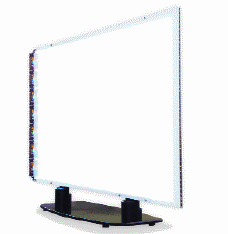
Gold Award: The PhlatLight BLU is a breakthrough for LED-backlit large-screen TVs because it enables these panels to be edge-lit with far fewer LEDs than had previously been possible.
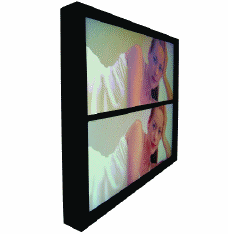
Silver Award: This shows a comparison of image qualities at an oblique angle for displays using FUJIFILM's WV-SA (top image) optical compensation film with the newly developed WV-EA film (bottom image), which was introduced in 2007.
|
Display Application of the Year
This award is granted for a novel and outstanding application of a display, where the display itself is not necessarily a new device.
Gold Award: Apple – iPhone
Unless you had somehow left the planet Earth in 2007, you are surely aware of the Apple iPhone, one of the most eagerly anticipated consumer-electronics devices in years. Introduced in June 2007, the iPhone created a frenzy of interest that superceded the buzz for any consumer-electronics device that had come before it.
From a display perspective, the iPhone is notable for what Apple calls the Multi-Touch display, a 3.5-in. (diagonal) widescreen display with a 480 x 320-pixel resolution at 163 ppi. According to a February 2007 article in Information Display by Geoff Walker (now the Director of Product Management for ELO TouchSystems), the iPhone uses projected-capacitive touch technology in two different implementations as described in Apple's patent application. The first, which Apple calls "self capacitance," is a simple passive array of 24 x 36 sensing electrodes in a single plane. Commonly known as a "matrix" touch panel, this is often used in applications such as industrial control panels, membrane keyboards, and other situations where a limited number of well-defined areas on a surface need to be made touch sensitive. Since it is basically a low-resolution architecture, it is not regularly applied to displays. The second implementation is a more-traditional structure consisting of two sets of parallel rows of transparent conductors, one on each side of a substrate, perpendicular to each other. Apple calls this implementation "mutual capacitance." What makes this remarkable is that Apple's firmware processes and outputs up to 15 simultaneous touches.
This gives the iPhone's user interface (UI) a tremendous amount of flexibility in terms of recognizing different types of touches, which is vital since there is no traditional phonepad – the entire display serves as the UI. The six fundamental touch-vocabulary elements (gestures) in the iPhone's UI are as follows:
• Single tap to select or activate something.
• Double tap to change the display format.
• Drag and drop to move something.
• A stroke ("swipe" or "flick") up/down/left/right to scroll.
• "Pinching" two fingers together to shrink something.
• "Spreading" (un-pinching) two fingers apart to enlarge something.
These elements work consistently everywhere throughout the iPhone's UI. For example, spreading two fingers apart zooms in on an on-screen photo or enlarges text/e-mail messages.
Pinching and spreading are the only touch-vocabulary elements that make use of multi-touch (multiple simultaneous touches), according to Walker. If the user is doing a pinch gesture, the array of data points output by Apple's firmware contains two sets of touch coordinates that are moving toward each other over time.
The iPhone's innovative touch screen and UI has earned it the Gold Award in the Display Application of the Year category.
Silver Award: RealD – ZScreen® and Electronic 3-D Cinema
It took 110 years from the birth of the cinema to release a perfected stereoscopic projection product. Numerous attempts at making such a product produced images that were uncomfortable to view and unreliable systems. The development of the electronic cinema created an environment in which stereoscopic technology can flourish. The key to stereoscopic projection is that a single electronic projector based on the Texas Instruments Digital Micromirror Device (DMD) light engine can take the place of two projectors to produce superbly coordinated and congruent images for both the left and the right eyes. The system is easy to install, set up, and use, and rarely requires calibration.
RealD created the electronic stereoscopic cinema and, as of today, licenses its product to 1148 theaters in 24 countries. The product is the ZScreen electro-optical modulator combined with a cross-talk reduction algorithm applied to release print files. The "Z" in ZScreen refers to the Z-axis of three-dimensional space, and the product offers the three-dimensional effect that comes with binocular stereopsis. The ZScreen encodes alternate left and right fields with circularly polarized light 144 times per second and the noise reduction algorithm, nicknamed "ghostbuster," subtracts the unwanted left image from the right and vice versa. Moviegoers are outfitted with comfortable plastic-framed disposable eyewear with circular polarizer analyzer lenses to select the appropriate image for the appropriate eye. Because both images pass through the same optical projection path, illumination and geometry are identical, and the high repetition of the field rate ensures that temporal congruence is emulated.
The ZScreen was developed by StereoGraphics Corp. of San Rafael, California, which was purchased by RealD in 2005. The team that created the ZScreen was lead by Lenny Lipton and included Art Berman and Lhary Meyer. Its original application was as a modulator for CRT monitors used for stereoscopic viewing of molecular modeling images for Evans & Sutherland workstations. The same team also designed the CrystalEyes product that has been the standard for scientific and engineering visualization for almost two decades. The ZScreen was developed into a projection device used with CRT projectors and then with DMD projectors. The modulator itself consists of a sheet polarizer in optical series with two pi-cells that are driven out of phase. The technology was first suggested by James Fergasen as a communications device, and he worked with Lipton to perfect its application to moving image projection. The ZScreen was applied for the theatrical application at RealD by a team lead by Josh Greer with Matt Cowan, who developed the cross-talk reduction process.
To date, half a dozen feature films have been projected in RealD cinemas beginning with Disney's Chicken Little in November of 2005. The 3-D Hannah Montana concert film, released early in 2008 almost entirely in RealD theaters, achieved the highest gross per theater of any motion picture in history. Films released both in 2-D and 3-D have done about three times the business in RealD-equipped cinemas capturing the attention of filmmakers and studios. A roster of about two-dozen features is scheduled for release in the next 2 years. The future looks bright for the stereoscopic cinema, which is experiencing a creative renaissance as filmmakers explore the new medium. This rebirth of the cinema is being enthusiastically greeted by audiences all over the world. For designing the leading system that has enabled this rebirth, RealD has earned the Silver Award in the Display Application of the Year category. •
|
DISPLAY APPLICATION OF THE YEAR

Gold Award: The Apple iPhone features an innovative multi-touch user interface that generated a tremendous amount of buzz in 2007.
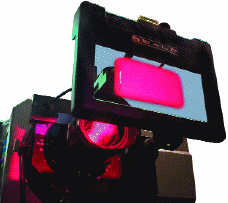
Silver Award: RealD ZScreen® and the Electronic 3-D Cinema has helped spark a renaissance in 3-D movies.
|
Michael Morgenthal is Managing Editor of Information Display
magazine; e-mail: mmorgenthal@pcm411.com.